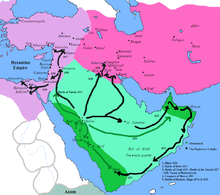Hijra
The Hijra (in Arabic, هِجْرَة, Hijra or Hijra) is the migration of Muhammad from Mecca to the city of Yatrib, later known as Medina (al-nabi), in the year 622, because the Quraichite chieftains of the first city did not accept his teachings on the new religion, Islam. Muhammad had been invited to Yathrib by a local group of Arabs. Muhammad sent his followers (known as Muhajirun) ahead and secretly followed them along with Abu Bakr bin Quhafa, leaving Ali in his own bed to deceive the Quraishites of Mecca. that they sought to assassinate him. On the way they stopped at a cave in Mount Thawr (Bull), where a cobweb hanging from the entrance fooled the Quraish, who decided not to search inside (Quran 9ː40). There, according to Sufi tradition, the Prophet taught Abu Bakr the secrets of 'silent remembrance'; (dhikr-e khafi), which gave Abu Bakr the title of Yar-e ghar, "Friend of the cave".
In Medina, known at the time as Yathrib, they were well received, even though the city was in a situation of internal crisis. Muhammad and a group of citizens from Medina agreed to a pact, a kind of constitution. In Medina the umma, a "community" made up of Muslims.
The word hiyra literally means "migration", not "flight", but it is sometimes mistakenly translated as such. The hijra has also been interpreted as "breaking the old ties", separating the age of knowledge from the previous age of ignorance (yahiliyya).
Background
According to Islamic sources
From Yathrib to Medina
Islamic sources describe the city of Medina as the seat of two competing Arab tribes (the 'Aws and the Khazraj), as well as three Jewish tribes (the Banu Qaynuqa, the Banu Qurayza and the Banu Nadir). It is further said that by the time Muhammad fled from Mecca to Medina in 622, he had in fact been invited by the ever-armed Aws and Khazraj tribes to serve as a neutral third party and ruler over them. who would follow Muhammad from Mecca to Medina to make this Hijra would come to be known as Muhajirun, or 'migrants'. These migrants would be distinguished from the 'Aws and Khazraj', who, having converted to Islam, would be subsumed under the title and role of Ansar, or 'helpers', who would serve as hosts to the Muhajirun.
The hijra also marks the division of the Qur'an, as the portion of the Qur'an produced during Muhammad's years in Mecca (the so-called Makki verses) focused almost entirely on personal matters of faith and worship, the Qur'anic verses produced during Muhammad's Medina years would focus on legalistic themes and military doctrine, transforming Islam, in large part, into today's religion.
Battles
During his years in Medina, the hadith records that Muhammad and his followers would engage in several raids on the Qurayshi caravans of Mecca and spark battles between the two cities, which the Muslims would win with varying degrees of success (the Battle of Badr in 624, the Battle of Uhud in 625, and the Battle of the Trench, or al-khandaq, in 627).
Fate of the Jews of Medina
By the time Muhammad is said to have amassed enough military forces to conquer Mecca, all of the Jewish tribes in Medina were wiped out, forced to leave, or wiped out entirely through battle, siege, or massacre.
Muslim calendar
Caliph Úmar ibn al-Khattab, establishing an Islamic calendar, chose this event as his starting point. Muhammad arrived in Medina in September 622 AD. The calendar opens with the first month of the Arabian lunar year in June 622 and proceeds without intercalation by a year of 354 days in accordance with the lunar months. Since the Muslim calendar counts by lunar years of 354 days, 8h, 44m and 54 s, 33 Muslim years are equivalent to 32 solar years and 6 days, 8h and 41m of the Gregorian calendar. However, it also intercalates 11 years of 355 days in each 30-year cycle.
The conversion of Muslim years to the Western calendar is done by adding 621, if the Hijri year does not exceed 32. If it exceeds 32, divide by 33, subtract the quotient from the given year and add 622 to the result.
For the reverse conversion, when the year is less than 641, subtract 621; if it is between 641 and 653, 620 will be subtracted, and if it exceeds 653, 621 will be subtracted, dividing the result by 33 and adding the dividend to the quotient will obtain the year of the Hegira (or sometime the following).
Contenido relacionado
Indonesian economy
Indonesian history
Swiss flag
